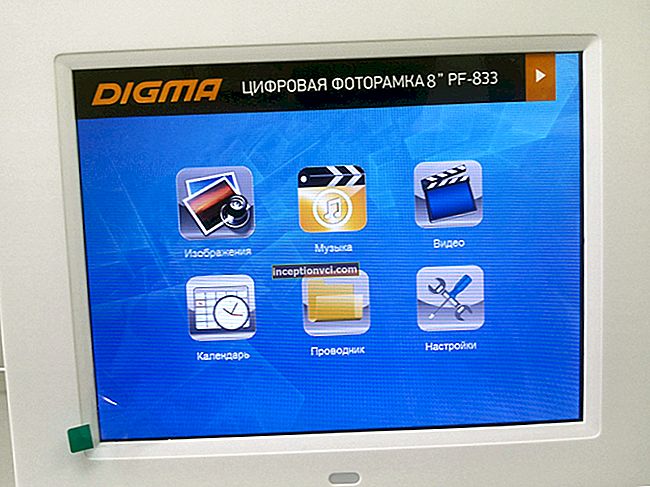Until recently, dinosaurs ruled the movie world. Avid of everything gigantic and majestic, Hollywood could not pass by the largest creatures that have ever inhabited the planet. After "Earth Before the Beginning of Time", "Jurassic Park", "Dinosaur" and English (but also popular in the USA) "Walking with Dinosaurs", many thought that the epidemic of love for huge lizards was forever. Scientists have even begun to talk about the possibility of creating real Jurassic Parks. Fortunately, the technologies of cloning and gene manipulation have made a big step forward in recent years, and any costs for such a project would have paid off millions of visitors.
But every fashion comes and goes. And now - the audience began to get tired of the endless tyrannosaurs and diplodocus. Moreover, these creatures became extinct millions of years before the appearance of man, and for us they can only be of purely scientific interest. You can certainly admire their size and sharp teeth. But it gets boring quickly.
However, there was another interesting time in the history of the Earth, when the most powerful and formidable predator appeared on the planet inhabited by unusual animals - man. This is the Ice Age - the era of mammoths, saber-toothed tigers and primitive people.
Quite naturally, when the popularity of dinosaurs began to gradually decline, the producers became preoccupied with finding a new historical theme. And they could not pass by the ice age. So at the Fox studio the idea arose to create the film "Ice Age", the action of which was to unfold during the time of the global cold snap.
This film was conceived as a childish, animated, solved in the most modern computer graphics technology, thanks to which all the above-mentioned "dinosaur" hits appeared. Therefore, for a start, it is useful to remember how animation originated and developed, created not on paper and celluloid, but on a computer monitor.
Living in a world filled with computers and CGI movies, it's hard to believe that just half a century ago, virtually none of this splendor existed. When, in the 1950s, IBM management announced that there would be no demand for more than five or six computers in the world, only science fiction writers could doubt the validity of these words. Nevertheless, it was during this period that the first experiments in the creation of computer cartoons fell.
In 1961, the world's first computer graphics game appeared - "Space Wars" by Steve Russell, which was later changed many times and became one of the most famous programs for PDP-1 computers.
The year 1963 was especially fruitful for innovations. It was then that the world's first exhibition of computer graphics took place in the United States, and at the same time Doug Engelbart invented the computer mouse, which became one of the most important tools for CG artists. That same year, Edward Hare of Bell Corporation presented the world's first fully-drawn cartoon, and IBM began selling the first commercial computer-aided drawing system.
Despite such impressive achievements, the graphics of the time were very primitive. Apart from purely technical applications such as drafting and graphing, it was used rather limitedly. Since computers were bulky and expensive, as well as low-power (according to modern concepts), it was not possible to create what is now called three-dimensional animation on them. Computer graphics as a field of art has long remained a curiosity, a sphere of narrow interests of hackers. Nevertheless, even then it became clear that she had a great future.The rapid development of technology and the parallel development of algorithms for displaying digital drawings with each passing day brought closer the time when computer graphics became an indispensable component of both cinema and animation.
In 1969, MAGI created the world's first computer-based television commercial for IBM. In the same year, the APRANET network was founded - one of the forerunners of the Internet, and Nolan Bushnell. the future creator of the Atari company, developed the first computer gaming machine. The development of computer animation has entered a new phase.
The beginning of the full-fledged world recognition of computer animation can be considered 1974, when the cartoon "Hunger" by Canadian animator Peter Folds received the Jury Prize at the Cannes Film Festival. By the way, a year later, simultaneously with the founding of Microsoft, at the University of Utah, the world's first 3D model of a physical object was created - the famous "tea pot", which is still included in all standard sets of computer graphics models. Now the teapot, which has become the prototype of this model, is kept in Boston, in the Computer Museum.
Two years later, in 1977, the world's first full-fledged personal computers Apple appeared, and the most famous computer animation among the early works in this field was created in Hollywood. Larry Cuba drew a computer model of the Death Star for the fourth episode of Star Wars. In the same year, the Film Academy established a new category for the Oscars - for special effects. Those interested in the history of computer graphics know that the first full-length motion picture to use it lavishly was called Tron.
It was created in 1980 by the already mentioned company MAGI, the pioneer of the commercial use of CG. Unfortunately, the enthusiasm of the artists working on this project was so great that they ignored the script or came up with scenes on the go. As a result, despite the special effects that were interesting for that time, the film turned out to be chaotic and failed at the box office.
However, this did not discredit the very idea of using CG in cinema. Two years later, she rehabilitated herself in the rather successful sci-fi action movie The Last Star Warrior. The effects in it were more interesting, since earlier computer graphics were used to create images that should look "computer", say, pictures on displays or virtual reality. In Warrior, however, computer effects were first used to "trick" the viewer into creating realistic looking computer models (in particular, spaceships) using CG tools.
Meanwhile, not only filmmakers, but also animators continued to be interested in computer graphics. So the studio Hanna-Barbera, known for such TV series as "Tom and Jerry" and "Scooby Doo", created a computer animation division in 1980, and in 1982, MAGI developed digital "compositing" technology, which made it possible to combine traditional ("manual ") And computer animation in one cartoon.
A new breakthrough came in the mid-80s and was associated with the success of the Lucastilm studio. It was her employees who in 1985, in the film Young Sherlock Holmes, created a completely “computer” character for the first time in cinema, and in 1987, after Willow, the effect of “morphing” became possible - the transformation of one character into another.
In the same years, the CG-studio Pixar appeared, whose cartoon "Luxo Jr." was nominated for an Oscar in 1986 (it was the first computer cartoon in the history of the animation nomination). In 1988, Pixar's Tin Toy won an Oscar, and in 1991 Pixar signed a multi-year contract with Disney to create three full-length computer cartoons, the first of which was Toy Story, released in 1995.
The further history of computer animation is not news to anyone who has watched Hollywood movies of the 90s.The brilliant special effects of Terminator 2, Jurassic Park, Titanic and Star Wars 1 (66 fully computer generated characters) ... The Babylon 5 series, which uses decent computer special effects for the first time on television ... The first completely computer animated 3D series "Overload" (held in our box office under the name "Computer Wars") ...
From a curious toy and a professional hobby, computer graphics have turned into a serious assistant for creators of special effects; this is the main and almost the only tool in the hands of animators. Even producers of traditional 2D animation prefer; use computers for final editing and debugging, and more recently for painting and keyframes, and even for character development.
The introduction of new technologies has made it possible to somewhat reduce the overhead costs of animation production and make it more profitable. As a result, in recent years, Hollywood has witnessed a real boom in expensive and high-quality full-length animation. This trend has already been noted by the American Film Academy, which has established a special Academy Award nomination for feature films. Recall that earlier it existed only for short films - there was not enough applicants to compete with each other.
Nature loves balance. When one wins and the other loses, the story of the advancement of computer graphics was temporarily the loser of Fox's animation division. The culprit was director Don Bluth, who was one of the leading animators at Disney in the late 1970s. However, his work as "Rescuers" did not suit the studio management with its average (by Disney standards) quality. In the end, Bluth, along with his subordinates, left Disney and took up independent work. It was he, together with the producer Steven Stilberg, who opened the gold mine of the "movie about dinosaurs" with the film "The Earth Before Time".
The idea of a fix for Bluth was a competition with Disney in the creation of expensive family full-length cartoons. To do this, he came to work at the Fox studio and in 1997 released Anastasia there - one of the most commercially successful projects in his biography.
Overjoyed by the success, Bluth proposed to Fox an even more ambitious project that would surpass everything that had previously been created in American animation (and, above all, in the history of Disney). It was the full-length cartoon "Titan after the Death of the Earth", which combined traditional two-dimensional and computer 3D animation at the highest technical level.
However, as a result, Bluth, having spent fabulous money (more than $ 70 million), earned less than half of this amount at the box office. There are several theories to explain this failure. According to the most popular, Bluth was wrong with the positioning of the film: he was not interesting for the family audience, and teenagers who are fond of science fiction preferred full-length films. But be that as it may, Fox suffered huge losses. A difficult but necessary decision was made on massive redundancies. The animation studio in Phoenix, which created "Titan", was simply closed. Blat was on the street.
However, this did not mean that Fox completely abandoned the idea of rivalry with Disney and creating its own animation. Having lost in an alliance with Blat, the studio management drew the necessary conclusions and began to look for a new candidate on whom it was possible to bet. Moreover, the applicant had to have his own studio and his own team.
The savior of Fox's ambition has been taken over by Chris Wedge, 40-year-old animator and creative director of Blue Sky Studios.Although there was only one directorial job in his portfolio, Wedge could not be called a newcomer to the world of CG in artistic animation: he began his career in his student years, working as an animator at the MAGI studio, just when Tron was being created there. Initially, Wedge did not intend become a computer animation specialist.
He just wanted to create cartoons and has been practicing this art since he was 12 years old. However, in the early 1980s, when Wedge graduated from animation courses, it was not so easy to find work in this specialty in Hollywood. Thus, he got into MAGI, and there, in addition to computer scientists, specialists in their own animation were also required.
Later Wedge became one of the founders of the Blue Sky company, which specialized in computer special effects and filming of commercials. Wedge has worked on famous films such as Alien 4 and Joe's Apartment. But in his heart he always dreamed of more than realizing other people's ideas. Wedge dreamed of directing. And the opportunity presented itself.
In 1998, Blue Sky, led by Wedge, created the Oscar-winning 3D animated short Rabbit (sometimes mistakenly translated as Rabbit). The main advantage of this film was not so much the plot and the director's decision, but the technically perfect computer animation. Wedge and his staff, as he himself said, "decided to see what their new software developments are capable of."
It's no secret that half of the success of computer animation depends not on animation artists, but on programmers. On how much they are able to force computers to implement the latest developments in the field of graphics algorithms. And it was precisely in this that Wedge's studio had few rivals.
Unlike its competitors, Blue Sky preferred quality over speed, using the most sophisticated rendering algorithms - model-based computer generated images. First of all, this concerned taking into account all possible sources of reflections and light. Blue Sky has also spent a lot of time and money creating fur reproduction algorithms - a subject of special pride for Wedge. As a result, despite the obvious stylization of the character designs, they looked as realistic as possible. Not as cold computer models, but as plush toys - a huge step forward for 3D technology. But at the same time, Wedge did not forget about the plot and the concept of the film. Such a talent could not go unnoticed. And so, in 2000, Fox studio invited him and his studio to work on the Ice Age project.
Once again, Fox could not make a mistake with positioning. Having burned themselves on "Titan", the producers knew that they needed to make a family film that would be interesting for both young children and their parents. And no tragedy. Maybe a few scary episodes, but the ending should be optimistic, and the film should be a comedy.
This is exactly what Fox put before Wedge; "We'll be working with Blue Sky if you make a comedy out of this story." Wedge could not refuse or argue, and he did not intend to. True, he was never a fan of animation for young children and did not consider himself a master of the comedy genre, but since he “took up the tug” ... As he self-critically remarked in one interview, “as dumb as I am, making a comedy is a sheer nightmare ".
Despite this Wedge got down to business in great detail. He studied all the literature on the ice age available to him and learned, for example, that there were many such periods in the history of the Earth. As a matter of fact, dinosaurs died as a result of global cooling. True, the cause of that ice age was not cyclical weather fluctuations, but a universal catastrophe - the fall of a huge meteorite. At least, the majority of scientists agree on this theory.
The Ice Age that interested Wedge was three hundred million years back from the time of the dinosaurs and began about twenty millennia ago.And, as the director noted with bitterness, the more he read, the more he realized that everything he had read would have to be forgotten and reinvented for the film. The unity of style and genre was more important than minor “correctness”.
The cartoon was based on a story already well known in the cinema. The three main characters - the mammoth Manfred, the sloth Sid and the saber-toothed tiger Diego - were supposed to deliver a human girl rescued by them after the death of her mother to her father. This plot was borrowed from the classic film "Three Godfathers" by John Ford, in which the legendary John Wayne played the main role. As a matter of fact, this sentimental story even before Ford survived two film adaptations and "Ice Age" became its fourth version. In American animation, it is not customary to pay much attention to human characters. Therefore, first of all, the ability to speak was taken away from them. As Wedge noted, "We made the film from the point of view of animals, and it is natural for them to think that people cannot speak." Therefore, the main focus was on animals. Due to the complexity of conveying emotions, the mammoth brought the most problems to the animators. First of all, because of the full possibility of gesticulation. As a result, all Manfred's feelings had to be expressed in his eyes - a very unusual and therefore difficult task for professionals brought up on the traditional principles of American animation. The popular comedian and star of the comedy series Everybody Loves Raymond, who voiced him, Ray Romano, also contributed to the creation of the image of Money. At first, Wedge did not even think about inviting Romano to this role. He believed that the mighty mammoth should be played by an actor with a deep, significant voice, such as James Earl Jones, who voiced Darth Vader. But this decision, according to the director, "was too commonplace." Romano's voice is not so deep, but it is bright and recognizable - this is not the voice of “some person”, but of a quite definite personality. For Romano himself, the role of Mani was a great test. As a professional comedian, he is used to working with partners and for the audience, and as a professional actor, he is used to backing his words with actions. But "when you stand in front of a microphone in the studio, none of this is possible." In the United States, it is not customary to record all the actors together so that they can play, "charged" with the energy of dialogue, each of them participates in scoring separately. Therefore, Ray had to actively use his imagination and try not to get into a fight with the microphone, working on the most active episodes. But all these problems paid off with interest when his children watched the film in whose eyes he looked just like a movie star. John Leguizamo, unlike Romano, already had experience of similar work, when he played in the same "Titan" by Bluth. So he quite got used to the need to voice alone and even found its advantages in this. According to him, this gives you more freedom to play as you want, and try more options to find what you need. However, he also had a big problem with the role, how to play a sloth. He reviewed many popular science films about sloths and was horrified that they had absolutely nothing to borrow from them. Sloths live up to their name - in the words of Leguizamo, "watching them is like looking at drying paint." But he still managed to catch one detail and use it. He heard in the film that sloths keep nuts behind their cheeks. So he came up with a special lisp in Sid's voice, which became his hallmark and was gladly approved by the director. And the temperament of the protagonist had to be borrowed from more traditional characters, say, from the rat, which Leguizamo voiced in "Doctor Dolitt" and, of course, from himself. No wonder that even in high school, classmates called him "the biggest talker." There was one more important role.Skrys ("saber-toothed rat"), not interested in anything other than saving his nut, against the will of the creators, became the most popular character in the film. Many even thought that this is a character from some "finished" short cartoon, inserted in the "Ice Age" so that "the material does not disappear." He was so hilarious and completely independent of the main plot of the film. In fact, it was invented specifically for "Ice Age" Wedge felt that the film lacked a sort of "driving force", so Skryss appeared and much more, which gave the picture additional dynamism. Mindful of the failure of "Throne" and "Titan", Wedge tried to do everything so that his creation avoided the same fate. And, besides adding details like the adventures of Skryss, something from the "Ice Age" had to be cut out. For example, Syd's love story and the corresponding female sloth character have been completely deleted. In addition, as often happens in the movies, the cartoon revealed scenes that looked good on paper in the script, but turned out to be unnecessary, unsuccessful or boring on the screen. They also had to be cut, fortunately, nowadays nothing just disappears, and a significant part of all cut fragments can be found on the DVD edition of "Ice Age". In addition to artistic difficulties, Wedge also faced organizational difficulties. Before receiving the order from Fox, Blue Sky employed about 70 people. Naturally, for the implementation of such a large-scale project, it was required to hire more than a hundred employees. And since they were highly paid specialists, the estimated budget for the "Ice Age" has grown significantly. Fox demanded to cut costs, as well as lay off "superfluous". But Wedge stood his ground. In the end, the conflict was resolved, but it took a lot of time and nerves. Releasing the film. Wedge was ready for criticism in advance. The fact is that the development of computer animation is almost the same at all studios. Therefore, such a graphic novelty as a super-realistic wool was perceived by the audience as borrowing, for example, from Monsters, Inc. But Wedge said in this regard the following: “If the film comes out now, it means that it was created for several years. And we could not “copy” from the films that were released a few months ago, since we ourselves saw them at the same time as the audience. " And sharing trade secrets in the computer graphics industry is not accepted - the development of its technology is too expensive. Fortunately, Wedge's fears did not materialize. Although Ice Age did not receive a particularly warm welcome from critics, it did not affect the box office fees. During the first weekend, "Ice Age" earned $ 47 million, setting a new Hollywood record. Evil tongues, however, attributed this phenomenal success to the "Star Wars 2" commercial shown before the film and assured that many viewers left the movie immediately after it was shown. While it's hard to deny that Lucas' blockbuster helped Wedge, it was the success of the Ice Age creators, not the Lucasarts wizards. And the audience continued to go to the cartoon even after the whole world had already watched the commercial for "Star Wars 2". Wedge proved that in show business there is always a place for a new player if he is a good professional. And now the Disney studio had to cry. In 2002, there began mass layoffs associated with falling profits and another crisis of ideas.























